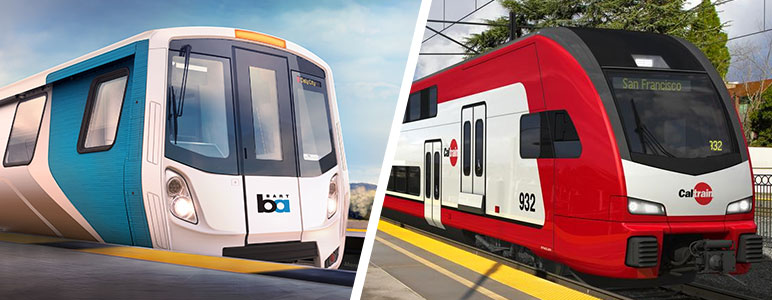


Two notable transportation electrification (TE) initiatives in California should be on people’s radar. First, the Bay Area Rapid Transit District (BART) is beginning to implement policies that increase its use of renewable energy. Second, under consideration is a $100 million allocation specifically for Caltrain’s Peninsula Corridor Electrification Project (PCEP). These two activities directly complement California’s Senate Bill (SB) 350 transportation electrification policy framework and are demonstrative of concrete, positive steps toward reduced greenhouse gas (GHG) emissions and pollution reductions.
BART’s renewable energy leadership
BART’s green system will be going even greener by adopting a new and progressive wholesale electricity policy. Notably, BART already operates some of the nation’s cleanest trains, but through this new and expanded sustainability vision, BART will further take steps toward fuel switching to clean, renewable energy for its electric trains. BART is executing this initiative under the provisions codified per SB 502, which essentially allows BART to act as a direct access customer for wholesale electricity and will leverage these provisions to implement this initiative. CSE worked with BART to help create its solar feasibility study. In addition, CSE supported SB 502 in 2015, authoring a letter of support on this important sustainability matter.
BART’s new Wholesale Electricity Policy will strike a balance by prioritizing low and stable BART operating costs while maximizing the use of low-carbon, zero-carbon and renewable electricity supply. To achieve this, BART has set the following portfolio goals.
- At least 50 percent eligible renewable sources by 2025
- 100 percent from GHG emission-free sources by 2035
- 100 percent from eligible renewable sources by 2045
Putting the magnitude of this policy in scope, BART uses as much electricity as a medium to large city (essentially the same as the city of Alameda), hence this policy is the equivalent of a local government setting the same ambitious yet achievable energy goals. By adopting this policy, which aligns with the state’s SB 350 transportation electrification policy framework (see previous blog), BART will join an exclusive pool of local California governments that have also independently set aggressive clean energy objectives. These cities include San Francisco, Palo Alto, Los Angeles, and others.
$100 million for Caltrain’s PCEP
Caltrain may receive enough funding to commence its TE infrastructure project. A few months ago, Caltrain received notification from the Federal Transit Administration that a $647 million funding agreement for the PCEP — a shovel ready project — would be deferred until the administration developed the president’s 2018 fiscal year budget. As a promising sign, the proposed 2017 federal budget package contains a $100 million allocation for Caltrain. While that amount will not cover the entire PCEP, it provides what appears to be enough funding to initiate key project TE activities.
Caltrain electrification is an integral element of the state’s TE policy. It is not simply swapping out diesel locomotives and replacing them with electric ones; it is about full-scale system electrification and efficiency. This efficiency and increased capacity will lead to additional ridership, and 88,000,000 kilowatt-hours (kWh) of electric-miles (e-miles) in 2020 will be used in lieu of diesel miles. In addition, investments in passenger rail promote economies of scale; they induce commuter mode shifts and maintain very high participation rates by providing few barriers to access and very high capacity on a passenger-per-mile basis. Moreover, since the system will operate on electricity, which can be created from solar and wind sources, rail TE creates the opportunity for travelers to use zero-emissions transportation, even without owning an electric car.
Pushing toward cleaner air
These two initiatives, and other similar ones, directly support California’s SB 350 efforts,[1] which recognize the need for deep decarbonization across the transportation sector as a priority to meet our long-term GHG emissions reduction goals. Electrifying rail also squarely fits within the recent California Public Utilities Commission (CPUC) decision to prioritize TE pilot experiments in diverse market segments, including rail projects, and fits within the wider ZEV goals embodied in the 2016 ZEV Action Plan, which notes the benefits of zero-emission rail systems. CSE’s recent comments, “Response to the Application of Pacific Gas and Electric Company for Approval of its Senate Bill 350 TE Program,” before the CPUC reflects our policy thinking on the opportunities to connect this crucial project as a potential TE investment under these emergent programs.
BART’s and Caltrain’s initiatives represent a step in a positive direction for the TE rail sector. BART’s efforts complement their current and expanding fixed guideway ecosystem, which accounts for more than 713,000,000 kWh of e-miles,[2] and Caltrain’s efforts will add another 88,000,000 kWh of e-miles. Rail TE initiatives will undoubtedly continue to be interwoven to supplement policies focused on achieving 1.5 million light-duty ZEVs on the roads by 2025, further bringing into fruition policies as embodied in the state’s ZEV Action Plan. Through these and other tactics, the state’s transportation sector will continue the path to deep reductions in criteria air pollutant, particulate matter, nitrogen oxides and GHG emissions.
[1] SB 350 fundamentally expanded the role of TE, placing it as a third stand‐alone category on equal footing with energy efficiency and renewable energy, and codifies TE as a key tool to meet the state’s 2030 and 2050 emission reduction targets.
[2] National Transit Database; NTD Data; Website access: 2015 Annual Database Energy Consumption.

